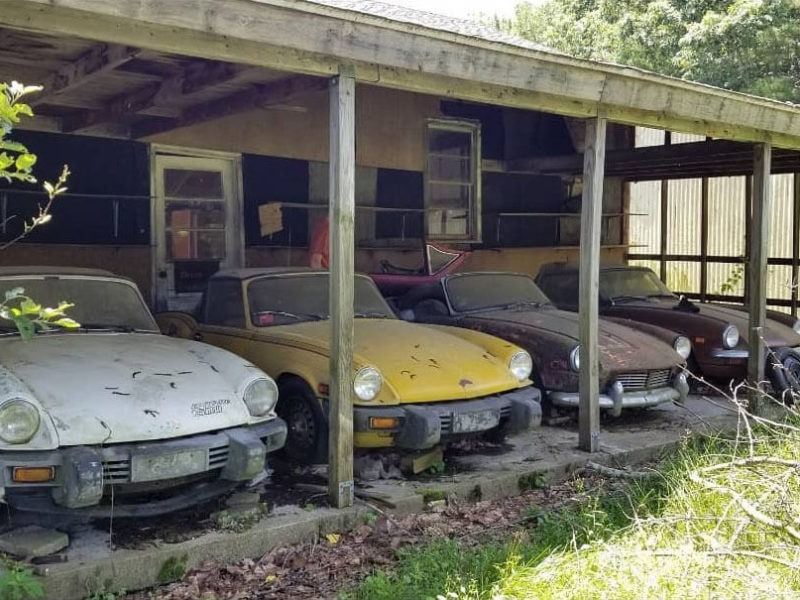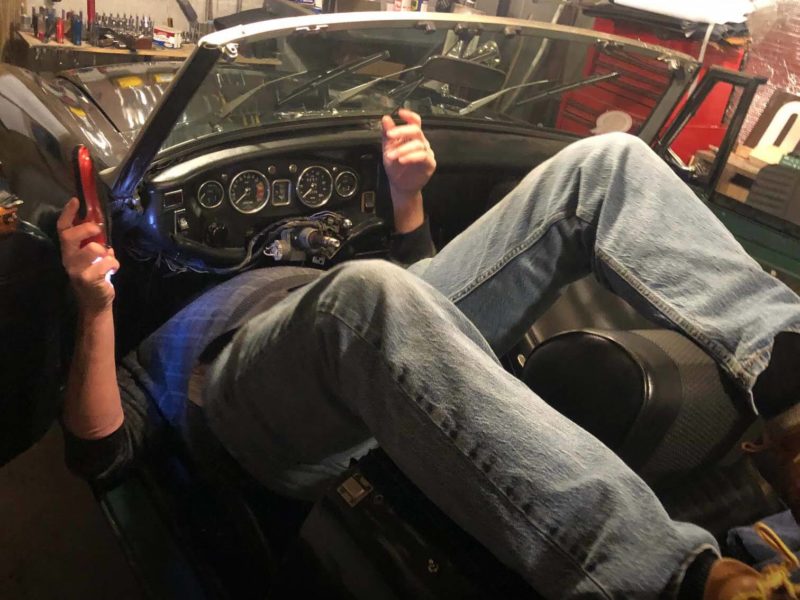A long, long time ago, when my wife and I started to shop for a car we fell in love with an MGB/GT, and this became our first new car in 1968. When our children came along and we needed more cargo space, we purchased a station wagon. Several years later, when our youngsters were becoming independent, we purchased another station wagon but also became a three MGB/GT family. During their final high school years, our daughter and son restored their own MGs (I supplied the parts, they did the work). My son still has his, but it has seen a lot of miles and is in need of restoration.
 Eventually the kids left home, and so did the last wagon. Since then the MG has been our daily driver, and now has over 500,000 miles on it. Thanks to the continued availability of repair/restoration parts, the car has been overhauled/restored three times. As the years crept up on me, I decided that in my late sixties it was becoming too difficult for me to muscle an internal combustion drive-train in and out of an MG; and this would definitely be unwise several years from now. So, this time around I decided to restore the body and interior, and convert the car to electric drive.
Eventually the kids left home, and so did the last wagon. Since then the MG has been our daily driver, and now has over 500,000 miles on it. Thanks to the continued availability of repair/restoration parts, the car has been overhauled/restored three times. As the years crept up on me, I decided that in my late sixties it was becoming too difficult for me to muscle an internal combustion drive-train in and out of an MG; and this would definitely be unwise several years from now. So, this time around I decided to restore the body and interior, and convert the car to electric drive.
Owner converted electric cars have been around for decades and you can attend an electric vehicle mechanic program if you wanted to learn. I remember admiring and electric MG at a Car Meet in the 1990s. Unfortunately, the lead-acid battery technology rendered the converted vehicles heavy on the gross weight, and light on the driving range. It was not uncommon to add a thousand pounds in batteries to achieve a limited range of 20-30 miles. For me this would not have been practical. This changed a few years ago with the introduction of Lithium Ion batteries. My electric MG has 36 Lithium Ion cells for total battery weight under 500 pounds; this is a common configuration for small cars.
I use an AC electric motor that weighs 115 pounds. It is coupled to the clutch and transmission with a custom made adapter. Such adapters are available for a wide range of cars. I decided to use a three synchro four speed gearbox; primarily because they weigh a bit less, and I have learned how to rebuild them. The gas tank, radiator, and exhaust system are now gone; however a small radiator with fans and water pump was added to cool the electronic control unit that regulates the motor. A large battery box for 18 cells resides where the gas tank used to be, and the original behind the seat battery boxes each house 3 more cells. The remaining 12 cells ended up in two boxes in the engine bay. This arrangement of parts gives the car a nearly 50-50 front-rear weight distribution.
I have given up the heavy duty engine hoist that popped the engines and trannys out of the MGs for the past three decades. The hoist and its parts are getting too heavy for me to manipulate. I picked up a light duty hoist that rolls around very nicely, and is perfect for positioning the motor/tranny combination and the front battery boxes in the engine bay. The rear batteries are installed one at a time since the fully assembled box is too large and heavy to maneuver in and out of the car.
The instrumentation turned out to be straightforward. Zero Emission Vehicle Australia (ZEVA) offers a device that monitors battery usage and displays battery charge level on regular fuel gauges, and also displays instantaneous power usage (amperes) on electronic tachometers! So, some of the existing MG gauges come in handy. A regular voltage gauge is useful to keep track of a small auxiliary battery that powers the lights and other 12 volt accessories. There are a number of devices available to monitor the state of charge of the main battery pack, some quite exotic. Actually, monitoring the state of charge of the battery pack is a big deal. Overcharging or over discharging the batteries tends to destroy them! Since the battery pack is the single most expensive component in the car, it makes sense to carefully monitor the amount of juice in the cells. I decided to add a second instrument to do this, an ampere hour meter that measures the number of amperes being added to or drained from the pack.
I find that the most reliable way to keep from running out of juice is to closely watch the trip odometer. I get anywhere from 60 to 85 miles per charge, depending on driving style; so charging around the 60 mile mark is a good idea. Both my wife and I are now retired, and a pit stop at the 220 volt plug one a week works well for us. The charger in the car can work with a regular 110 volt socket, but that takes about 16 hours for a full charge; so I use the 220 volt dryer circuit instead to get a full charge in 8-10 hours. Public charging stations are becoming available, but I have not bothered to install the equipment needed to use them.
 The batteries can be charged around two thousand times before they start to loose capacity. That gives the car a good twenty year lifespan, if they are charged a couple of times a week. I expect that by then one of my grand children or great grand children will be driving it, and hey will experience the pleasure of restoring a classic car. More than likely the next big even in the life of this car will take place in four to five years when the battery technology will have advanced enough to triple the driving range. Then I can install the next generation of cells to regain the freedom to go touring in the MG.
The batteries can be charged around two thousand times before they start to loose capacity. That gives the car a good twenty year lifespan, if they are charged a couple of times a week. I expect that by then one of my grand children or great grand children will be driving it, and hey will experience the pleasure of restoring a classic car. More than likely the next big even in the life of this car will take place in four to five years when the battery technology will have advanced enough to triple the driving range. Then I can install the next generation of cells to regain the freedom to go touring in the MG.
By Bela Banathy









'MGB GT Reborn Electric' have 25 comments
October 19, 2013 @ 8:01 am Anton
Unbelievable! I wish both of you happy electrical motoring for many years to come!
December 9, 2013 @ 5:33 am Altezza
Kedves Béla,
Jó írás, tetszik az autó. Az enyém is ilyen, igaz az nem elektromos.
🙂
[-Ed … Google translation from Hungarian follows]
Dear Bela, Good writing, I like the car. The mine is one, it is not electric.
March 26, 2014 @ 10:46 pm Mark J. Miller
I have a ’73 MGB (since ’76, though not quite as long as you have had your GT).
How much did the conversion cost?
With some adjustment or technology, can the range be extended to 100 or 120 miles?
May 9, 2014 @ 9:58 am Bela Banathy
Mark … I spent $9K on the batteries, $4K on the motor and controller, $1K on the transmission adapter plate, and another $1K on the charger and DC-DC converter, so a total of about $15K …. I bought most of this about two years ago, today the cost would be $2K lower .. the biggest item was the batteries … I got CALB (China Aviation Lithium Battery Company) CA180FI 180AH LiFePo4 cells that had just been introduced, CALB has just annouced a newer generation of cells that have even more capacity and weigh less! … so, today the cells I am using would cost less … or you could pay about the same for higher performance … if I keep the highway speeds at 55 or lower and drive very conservatively I can get up to 90 miles per charge, but 80 max is safer since totally draining the batteries shortens their life span … the newest batteries should yield 100 miles or more … this has been a real fun project!, driving around in a silent MGB is a real joy …. keep in touch, Bela
March 31, 2014 @ 7:47 pm D J Overby
Good article. Thanks. You, obviously, did most of the work. Can you give me an idea of the overall cost of parts? USD I have a 1978 MGB I would like to conver.
May 9, 2014 @ 10:12 am Bela Banathy
Hi … I spent $9K on the batteries, $4K on the motor and controller, $1K on the adapter plate, and another $1K on the charger and DC-DC converter, so a total of about $15K …. I bought most of this about two years ago, today the cost may be $2K lower … with the exception of welding the battery boxes, I did all of the work myself … I spent a lot of time restoring the car body (mostly rust eradication), and I completely re-built the wiring harness and spent a lot of time designing and installing the high voltage wiring so that it would be fully isolated from the body and the 12V system … for safety reasons I partitioned the batteries into three banks of 40 volts each (isolated by contactors/relays) …. I installed a 76-80 style dash for better instrument location and the glove box … this was a fun project … keep in touch, Bela
March 6, 2017 @ 11:16 pm robert chow
great article consider the infancy of lead battery to lithium. just wonder why he didn’t try hybrid, or perhaps now readily available. it would extend battery lifespan. but again depends on owner preference either total electric or hybrid. i thought on converting but i love to hear the old classic sound than wheezing tailpipe. still great to know it can be converted. thanks, bob
April 21, 2017 @ 9:41 am Bela Banathy
I did not consider the hybrid option because of the ICE maintenance issues. As is, the only maintenance tasks are: brakes, suspension, tranny, rear axle, and the small cooling system for the motor controller (the coolant needs to be changed ever 4-5 years, about the same as brake fluid changes). I have to admit that I used to enjoy the sound of a well-tuned MG engine, but driving in near complete silence is addictive.
October 8, 2017 @ 9:23 am Ricky Wright
Hi I have a 73 MGB and would like to convert to EV
Any Pointers or Ideas in 2017/2018 on New Technology , Batteries , what To and Not to do recommendations , Businesses etc.
Would be willing to Pay as a Consultant …..
Thanks very much for any Help !
December 24, 2017 @ 8:32 am Bela Banathy
Ricky … HPEVS has a better/upgraded controller now, it allows you to change the amount of regenerative braking on the fly with the flip of a switch … I would use their setup and control the regenerative braking with the overdrive switch … you can actually set the braking to be powerful enough to drive without the use of the brake pedal in many circumstances … I bough a Chevy Bolt this year so that I could commute 200 miles to see my grandkids, and the Bolt lets you control the baking the same way, so I drive without using the brake pedal except for in emergencies …. The battery technology has changed a lot, but the new generation of batteries are not yet available to us … although you can buy used tesla batteries, I personally prefer the the type that I used (and most people still use) because of the safety factor .. these units are nearly indestructible … I expect that higher energy density units will be available within a year … I would start the conversion now with the drivetrain, and purchase the batteries later on … If you have any experience with electronic circuits and building computers and/or micro/controllers then you could build really fantastic battery monitoring and charge controlling units for a couple of hundred dollars … I plan to build a replacement unit for the controller that I built a couple of years ago ….. Good luck with the project, and keep in touch … Bela
March 7, 2023 @ 1:43 pm John
Hello Bela, I love this article. I recently bought a 1980 MGB and have been struggling deciding to restore the emissions system to meet CA DMV smog test, or to convert to EV. I would love to hear any updates you may have, conversion shop recommendations, and equipment or battery ideas. Ultimately I would hope to get up to Sacramento to meet-up at a local Cars and Coffee in your area (I’m buying breakfast & coffee in thanks for your kind sharing on this thread!)
Retired in San Francisco.
Thanks in advance
December 24, 2017 @ 9:05 am Bela Banathy
Ricky … I live in the Sacramento area … if you reside in the vicinity, perhaps we an get together … I am a member of the United British Sports Car Club Sacramento .. that would be a good point of contact …. Bela
July 29, 2017 @ 7:07 pm Scott Sewell
Wonderful article! Would you be able to share the manufacture/model number of your AC motor? Do you think that’s still the best technology?
Having just frozen up my ICE, I’m trying to convince my wife to take on this conversion 🙂 I like the idea of getting out of the petroleum business (or at least a little more).
December 24, 2017 @ 8:36 am Bela Banathy
Hi Scott … The HPEVS motor/controller combo that I used is still a good choice … they have actually improved/re-programmed their controller to give you much better control of the regenerative braking on the fly, with the flip of a switch …. my reply to the posting just before your’s gives more details …. good luck with the conversion … I live in the Sacramento area, if you reside near by we can get in touch …. Bela
February 24, 2019 @ 11:08 pm Mitch Utsey
Thank you for sharing this. I teach High School Auto Shop. We have just had an MGB GT donated to us, sans drivetrain. I built an EV a few years ago, but was quite dissatisfied with the kit that we used, and want to do it “right”. Seeing what you have done here gives me hope that I and my students can pull this off!!!
October 11, 2019 @ 9:23 am Bela Banathy
Hi Mitch This sounds like a good project. The only major change to my car has been the addition of improved instrumentation. I built a small micro-controller to monitor battery usage and charging status. This provides warning signals when the voltage or current exceed acceptable limits, it also turns on the brake light when strong regeneration kicks-in to slow the car down; it also sounds an alarm when charging is complete. The only mechanical problems have been slow oil leaks in the rear end )I forgot to change the front oil seal on the differential when I re-built the car, also a slow leak in the steering rack and also the tranny. So, I need to top-up the fluids about once a year. The cost of batteries has NOT decreased as much as I was hoping for, the cost of the HPEVS drive system has come down a bit. I don’t have any useful advice on drive-train improvements. Take care and enjoy this project, Bela
November 24, 2021 @ 10:11 am robert chow
hello mitch, why not form a weekly EV car enthusiasts workshop off your school site. i’m sure there are plenty of folks who love to do EV conversion with their old classic sports car. i for one would love to convert my 1971 MG BGT if someone can give an extra expertise on electronic hook-up. i live in Patterson ca and retired in 2002 with a major airline UA as a jet engine technician. we can exchange more detail if you interested.
January 9, 2020 @ 4:11 am Michael O'Brien
Hi Bela I hope this site is still active. I’m going to convert a MG midget to electric and I am on the lookout for any and all information about this. I found this article very helpful and would like to know how your conversion is oerforming now.
Regards Michael.
November 11, 2021 @ 10:22 am Bela Banathy
Hi Michael,
The car is running well. I drive it to car shows in the Sacramento area. It still gets around 70 miles per charge. I am going to change the coolant pump in the cooling system; it is beginning to make grinding sounds, the coolant is eight years old! I should probably change the brake fluid also. I am disappointed to see that the price of the CALB CA180 cells have not come down; by now they should be under $100 per cell. My son is driving a restored 1957 Magnetite, and I would like to convince him to convert it electric drive (I have a spare motor to tranny adapter and an aluminum flywheel) but this will not be an attractive option until batter prices come down. I hope you can find a less expensive source of LiFePo4 cells; these are by far safer than the ones used in commercially available EVs. My daily driver is a 2017 Chevy Bolt; a great car with high energy density batteries, but they take a lot of circuitry and software to keep them safe. I hope your project is going well; it should be a lot of fun.
June 16, 2020 @ 4:24 am Jason
Just blew out the engine in our MGB. I might as well make the switch. Did you keep any of your contact info and keep good notes I could have so I can do the same to ours?
November 11, 2021 @ 11:29 am Bela Banathy
Hi Jason,
Details that may help: HPEVS AC 50 motor, check out their website, they give you a number of options with different performance curves. I used a 3 synchro tranny since it is easier to install than the 4 synchro variety. Since I drive around in 4th gear most of the time, there is no need for the convenience of the 4 synchro. I very rarely use 1st gear. As I recall I manufactured the motor mounts from 1/2″ thick 6″ x 6″ aluminum angle stock purchased from an on line metal supplier, don’t recall the website. I cut out the gas tank and built the main battery box around an aluminum angle stock frame wrapped in layers of kevlar, carbon fiber and fiberglass. I think I had about 2 layers of each for a very strong box that is very light. I did the same thing to to center battery box; and built two separate battery boxes for the front; one behind the controller and one in front of it. I covered all of the battery boxes by cutting and shaping polycarbonate panels; they are easy to heat and bend. I have a chill plate on the controller, with a small aluminum radiator mounted underneath the body, up front. I used the type of cooling system used to cool high powered tower computers; got most parts from frozencpu.com. I have a main power cutoff switch in the padded center console with cupholder; the switch is connected to the actual cutoff switch in the rear batter box using a cable. I use two contactors to partition the battery pack into three 40 volt segments; this is in addition to the main contractor that is switched on/off by the controller when 12v ignition signal is applied. I think it is important to segment the battery pack since a 40 volt jolt may hurt by a 120v jolt might kill you, especially since we are talking about several hundred amps! I had a hard time finding a charger that would fit in the available space, I ended up with an ELCON PFC2500 that works well. One last note: if you are comfortable building microcontrollers, I built a Teensy microcontroller the do some housekeeping functions: measure pack voltage and pack current, stop the charger when the charging current drops low enough to indicate end of charge cycle, beep when charging is completed, turn on the brake lights when regenerate-braking is active, and keep track of battery pack state of charge. The microcontroller is nice to have, but the car functions perfectly well without it; but you will need to install a switch that enables the charger. I use a GPS speedometer that works well, except inside tunnels, or on the lower deck of two story bridges. I use a ZEVA fuel gauge driver to measure battery pack state of charge, it has been reliable, That all I can think of for now. This should be a fun project, I hope you enjoy it and get may years of silent, safe motoring.
November 7, 2021 @ 7:52 pm John Perkins
Bela: Are you still driving your MGB-GT EV? Have you upgraded batteries?
August 21, 2023 @ 11:53 am Bela Banathy
Hi John,
I drive only to local MG shows. There is no need to upgrade the batteries since I have not driven the car much during the past few years. I do need to replace the coolant pump that keeps the controller cooled; it is beginning to make noise since I have not replaced the cooling fluid. Basically the rest of the system is like new.
September 16, 2022 @ 6:09 pm Clark Ward
Bela, who made the adapter plate for the motor to the transmission? Thank you for sharing all your info 🙂
August 21, 2023 @ 11:59 am Bela Banathy
Hi Clark,
A mechanic in Santa Cruz made the adapter plate. I think he is now retired. A web search should yield some other sources; I recall having a couple of other machine shops in the San Jose area that I could have used. I will try to dig-up the contact info for the original mechanic. BTW I drive around in 4th gear (that is direct drive) most of the time; so if you live in a flat area, you could consider leaving out the tranny and driving the rear axle directly.